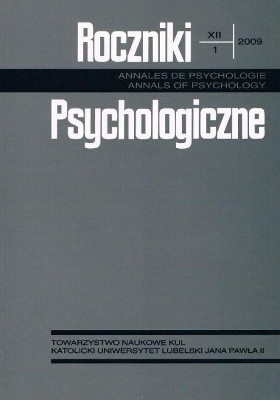Use of Stereotype Content Model in Describing Work Groups in Poland
Abstract
In this study, the Stereotype Content Model was used to determine if work related out-group traits represented on Competence and Warmth dimensions would be helpful in describing Polish work groups and potential interactions that may occur between them.
The study was performed on a group of 98 participants.
Taken that the Stereotype Content Model is based on stereotypes within intergroup function and analyzing this study results in the conclusion that by using the The SCM, it is possible to effectively describe and observe out-group interactions in the Polish work environment.
References
Aronson, E., (1999). The Social Animal. Worth Publishers, W.H. Freeman and Company.
Aronson, E., Wilson, T., D., Akert, R., M., (1997). Psychologia Społeczna. Zysk i S-ka Wydawnictwo.
Buss, D., Kendrick, D. (1998). Evolutionary Social Psychology. In D.T. Gilbert, S.T. Fiske, G. Lindzey (Eds.), The Handbook of Social Psychology (pp. 982-1025). New York: McGraw-Hill.
Clausell, E., Fiske, S.T. (2005). When do Subgroup Parts Add Up to the stereotypic Whole? Mixed Stereotype Content for Gay Male Subgroups Explains Overall Ratings. Social Cognition, 23, 161-181.
Cuddy, A.J.C., Fiske, S.T. (2002). Doddering, but Dear: Process, Content, and Function in Stereotyping of Elderly People. In: T.D. Nelson (Ed.) Ageism (pp. 3-26). MIT Press.
Cuddy, A.J.C., Fiske, S.T., Glick, P. (2008). Warmth and Competence as Universal Dimensions of Social Perception: The Stereotype Content Model and the BIAS Map. Advances in Experimental Social Psychology, 40, 61-149.
Dovidio, J.F., Britham, J.C., Johnson, B.T., Geartner, S.L. (1996). Stereotyping, Prejudice, and Discrimination: Another look. In C.N. Macrae, C. Stangor, M. Hewstone (Eds.), Stereotypes and Stereotyping (pp. 276-319). New York: Guilford.
Eckes, T. (2002). Paternalistic and Envious Gender Stereotypes: Testing Predictions from the Stereotype Content Model. Sex Roles, 47, 99-114.
Fiske, S. T., Cuddy, A. J., Glick, P., Xu, J., (2002). A Model of (often Mixed) Stereotype Content: Competence and warmth Respectively Follow from Perceived Status and Competition. Journal of Personality and Social Psychology, 82, 878-902.
Fiske, S.T. (1998). Prejudice, Stereotyping, and Discrimination. In D.T. Gilbert, S.T. Fiske, G. Lindzey (Eds.), The Handbook of Social Psychology (pp. 357-411). New York: McGraw- Hill.
Fiske, S.T., Cuddy, A.J.C. (2006). Stereotype Content Across Cultures as a Function of Group Status. In S. Guimond (Ed.), Social Comparison Processes and Levels of Analysis (pp. 249-263). Cambridge University Press Fiske, S.T., Cuddy, A.J.C., Glick, P. (2007)a. The BIAS Map: Behaviors from Intergroup Affect and Stereotypes. Journal of Personality and Psychology, 92 (4), 631-648.
Fiske, S.T., Cuddy, A.J.C., Glick, P. (2007)b. Universal Dimensions of Social Cognition: Warmth, then Competence. Trends in Cognitive Science, 11, 77-83.
Fiske, S.T., Xu, J., Cuddy, A.C., Glick, P. (1999). (Dis)respecting versus (dis)liking: Status and Interdependence Predict Ambivalent Stereotypes of Competence and Warmth. Journal of Social Issues, 55(3), 473-489.
Glick, P., Fiske, S.T. (2001). Ambivalent Stereotypes as Legitimizing Ideologies: Differentiating Paternalistic and Envious Prejudice. In J. Jost, B. Major (Eds.), The Psychology of Legitimacy (pp. 278-306). Cambridge University Press
Jackman, M. R. (1994). The Velvet Glove: Paternalism and Conflict in Gender, Class and Race Relations. Berkeley: University of California Press.
Jones, J. M. (1997). Prejudice and Racism. New York: McGraw-Hill.
Katz, D., Braly, K. (1933). Racial Stereotypes of One Hundred College Students. Journal of Abnormal and Social Psychology, 28, 280-290.
Nelson, T., D. (2004). Ageism: Stereotyping and Prejudice Against Older Persons. MIT Press.
Nelson, T., D. (2005). Ageism: Prejudice Against Our Feared Future Self. Journal of Social Issues, 61 (2), 207-221.
Nelson, T., D. (2006). The Psychology of Prejudice. Pearson Education, Inc.
Plous, S. (2003). The Psychology of Prejudice, Stereotyping, and Discrimination: An Overview. In S. Plous (Ed.), Understanding Prejudice and Discrimination (pp. 3-48). New York: McGraw-Hill.
Rosenberg, S., Nelson, C., Vivekananthan, P.S. (1968). A Multidimensional Approach to the Structure of Personality Impressions. Journal of Personality and Social Psychology, 9, 283-294.
Wilkinson, J. A., Ferraro, K. F. (2004). Thirty Years of Ageism Research. In, Ageism: Stereotyping and Prejudice Against Older Persons (pp. 393-358). MIT Press.
Copyright (c) 2009 Roczniki Psychologiczne

This work is licensed under a Creative Commons Attribution-NonCommercial-NoDerivatives 4.0 International License.


